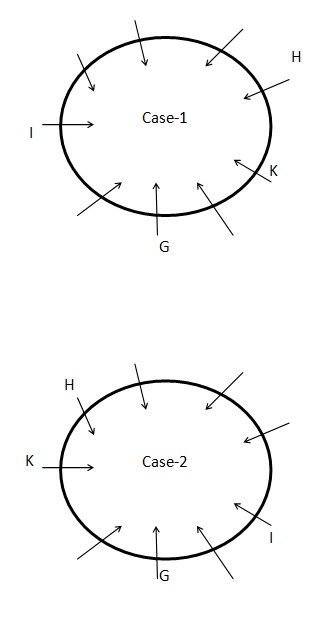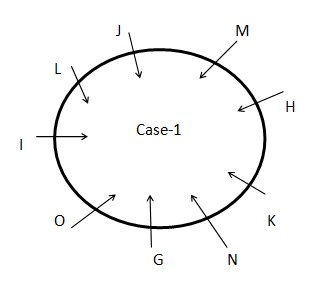Question
If all the persons are made to sit in alphabetical order
in a clockwise direction with respect to G, then how many persons remain unchanged in their position, excluding G? Answer the questions based on the information given below. Nine persons viz. G, H, I, J, K, L, M, N and O are seated in a circular table such that all of them are facing towards the centre, but not necessarily in the same order. The consecutive alphabetically named person doesn’t sit adjacent to each other. One person sits between G and K who sits adjacent to H. Four persons sit between H and I who doesn’t sit adjacent to G.J sits to the immediate right of M. The number of persons between M and I is one less than the number of persons between L and N, when counted from the right of both M and L.Solution
One person sits between G and K who sits adjacent to H. Four persons sit between H and I who doesn’t sit adjacent to G. The consecutive alphabetically named person doesn’t sit adjacent to each other.  J sits to the immediate right of M. The number of persons between M and I is one less than the number of persons between L and N, when counted from the right of both M and L. Hence, cases 2 get eliminated.
J sits to the immediate right of M. The number of persons between M and I is one less than the number of persons between L and N, when counted from the right of both M and L. Hence, cases 2 get eliminated. 
Which of the following pair regarding sound is correct?
I. Loudness – depends on amplitude
II. Shrillness – depends on frequency
The pitch of a sound is primarily determined by which of the following?
An athlete can jump farther by running before jumping due to which type of inertia?
Which of the following is an example of longitudinal waves in a gas medium?
The current across the 3 ohm resistance in the given circuit is:
A 220 V, 100 W bulb is connected to a 110 V source. Calculate the power consumed by the bulb
The force of attraction between two masses is called —
A meter stick moves along its length with a certain speed. The apparent length of the moving meter stick as measured by a stationary observer on the gr...
Which of the following is the energy quantum of radiation?
The group velocity of matter waves associated with a moving particle is:
Relevant for Exams:



